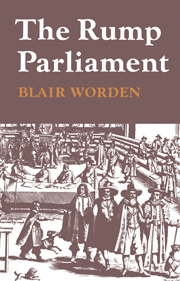Book contents
- Frontmatter
- Contents
- Dedication
- Acknowledgements
- Author's Note
- List of abbreviations
- Introduction
- PART ONE THE RUMP AND THE RUMPERS
- 1 Membership, attendance and allegiance
- 2 The limits of revolution
- 3 Moderation and conformity
- 4 Soldiers and clergymen
- 5 Commitment and corruption
- PART TWO THE RUMP AND REFORM
- PART THREE THE STRUGGLE FOR SURVIVAL, FEBRUARY 1649–SEPTEMBER 1651
- PART FOUR PARLIAMENT versus THE ARMY, SEPTEMBER 1651–APRIL 1653
- PART FIVE THE DISSOLUTION OF THE RUMP
- APPENDICES
- Bibliographical Guide
- Index
3 - Moderation and conformity
Published online by Cambridge University Press: 29 January 2010
- Frontmatter
- Contents
- Dedication
- Acknowledgements
- Author's Note
- List of abbreviations
- Introduction
- PART ONE THE RUMP AND THE RUMPERS
- 1 Membership, attendance and allegiance
- 2 The limits of revolution
- 3 Moderation and conformity
- 4 Soldiers and clergymen
- 5 Commitment and corruption
- PART TWO THE RUMP AND REFORM
- PART THREE THE STRUGGLE FOR SURVIVAL, FEBRUARY 1649–SEPTEMBER 1651
- PART FOUR PARLIAMENT versus THE ARMY, SEPTEMBER 1651–APRIL 1653
- PART FIVE THE DISSOLUTION OF THE RUMP
- APPENDICES
- Bibliographical Guide
- Index
Summary
On 29 January 1649, when ‘one of the late secluded members’ managed to take his seat, the Rump resumed discussion of the question of readmitting M.P.s. It decided to adhere to the principle previously adopted of excluding those who had voted the wrong way on 5 December: they ‘should not be readmitted, but disabled to sit any longer members for the future’. On 1 February, however, two days after Charles's execution, the House again ‘spent much time about reception of members, that so they might go on without interruption, in the intended settlement. Divers members having, since the death of the king, intimated a desire to come in, and some before’, the Rump ‘at last’ resolved on a change of policy. Those who had voted for further negotiations on 5 December were to be allowed to acknowledge the error of their ways and, after registering dissent, to resume active membership. On the same day thirty or more M.P.s dissented accordingly, and a large committee was set up to receive further assurances of dissent from members who would then be allowed to take their seats without official approval from the House itself. Those who failed to dissent by the end of February were, admittedly, to be subjected to much closer scrutiny, but it is likely that at least another forty members had dissented by the 22nd, making a total of about seventy since the king's death.2 In the three weeks after the execution, the Rump's active membership grew almost daily.
- Type
- Chapter
- Information
- The Rump Parliament 1648–53 , pp. 61 - 73Publisher: Cambridge University PressPrint publication year: 1974
- 1
- Cited by



